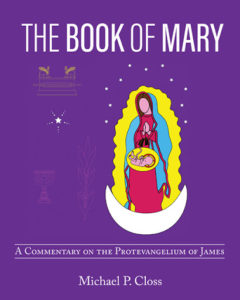Book Note: The Book of Mary by Michael P. Closs
Michael P. Closs. The Book of Mary: A Commentary on the Protevangelium of James. Victoria, BC: Friesen Press, 2016.
 This self-published commentary by retired University of Ottawa professor Michael Closs is a welcome tool for study of Prot. Jas., as there are few other commentaries available on the text—indeed, there are few available on any apocryphal texts! It is presented as a refutation of Émile Amann’s classic study, Le Protévangile de Jacques et ses remaniements latins: Introduction, textes, traduction et commentaire (1910). Closs opens page 1 with the statement: “This commentary will show that Amann’s work is seriously flawed and that later assessments of the Protevangelium are equally incorrect. The Protevangelium is a very different type of document than has been envisaged and its contents shed light on the earliest theological developments in marian dogma.” Closs claims instead that, “the intent of the author is to write a theological narrative with the goal of understanding Mary in relationship to her son. Its purpose is not so much to defend Mary as to reveal who she is, given that she is the mother of Jesus” (8).
This self-published commentary by retired University of Ottawa professor Michael Closs is a welcome tool for study of Prot. Jas., as there are few other commentaries available on the text—indeed, there are few available on any apocryphal texts! It is presented as a refutation of Émile Amann’s classic study, Le Protévangile de Jacques et ses remaniements latins: Introduction, textes, traduction et commentaire (1910). Closs opens page 1 with the statement: “This commentary will show that Amann’s work is seriously flawed and that later assessments of the Protevangelium are equally incorrect. The Protevangelium is a very different type of document than has been envisaged and its contents shed light on the earliest theological developments in marian dogma.” Closs claims instead that, “the intent of the author is to write a theological narrative with the goal of understanding Mary in relationship to her son. Its purpose is not so much to defend Mary as to reveal who she is, given that she is the mother of Jesus” (8).
The study works through the text chapter-by-chapter in English, providing along the way a paraphrase of Amann’s commentary with critique and additional comments, and his own explanatory notes. The book’s layout is a model of clarity, with HB/OT parallels in yellow callouts, NT in pink, patristic authors in green, rabbinic texts in orange, and large quotations from scholars in blue. Closs’s notes at times delve deeply into the text, with much attention paid to key issues such as the possible existence of temple virgins who weaved the temple veil (as Mary does in Prot. Jas. 10). It is unfortunate, however, that the text is presented, and interpreted, only in English translation. In constructing his text, Closs has drawn upon four previous translations: Amann, Walker, and Elliott (all translations of Tischendorf’s edition), and Hock (a translation of Emile de Strycker’s edition of Papyrus Bodmer V). This is an odd strategy, made necessary, I assume because Closs does not have facility with Greek.
The book concludes with five short studies presented as appendices: Attributes of the Author (of Jewish descent and priestly lineage, and perhaps even a woman), the Theology of the Narrative, Dating the Manuscript (i.e., the composition of the text), On Revelation 11:19-12:5, and Liturgical Connections.
The Book of Mary can be ordered from Friesen Press, and is available in hardcover, paperback, and as an e-book for only $10.99. The following abstract is from the publisher’s web site:
This commentary provides a new paradigm for understanding the Protevanglium of James, an early Christian manuscript that was marginalized in the West in the late 4th century but continued to be highly valued in the East.
The Protevangelium has long been recognized as the single most important manuscript associated with the development of marian dogma in early Christianity. The theology of the manuscript and the interpretation of its contents, however, have been woefully misunderstood for almost two thousand years. The present work reveals that the Protevangelium is a theological presentation of Mary in the same genre as the infancy narratives of Matthew and Luke. The story of Mary in the Protevangelium tells of a Jewish maiden whose unique vocation was to be the mother of the holy one, the Son of the Most High. The christological awareness in Gospel times was sufficient to single out Mary’s place in salvation history. However, it was her role as a holy of holies of the divine presence—a role that can only be understood within the holiness tradition of the Jewish people—that first engendered her veneration among early Christians.

Your review is spot on! I have been looking for this book. It is now out of print, and the copy I obtained was lost in the mail. Having read what I could off of Google Books, it merits reprinting.
Having Read Stephen Shoemaker’s works on Mary, I believe that Closs’s thesis is correct.
I am trying to get a hold of Closs as his book should be reprinted.